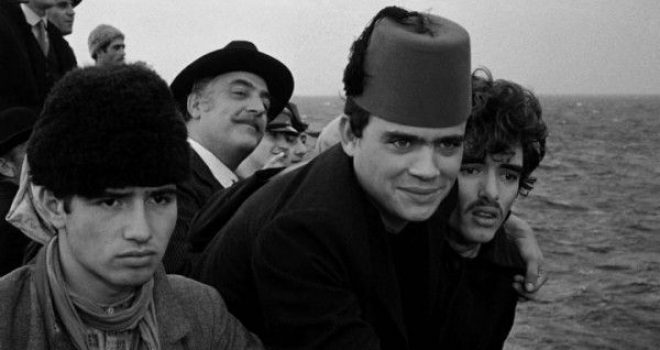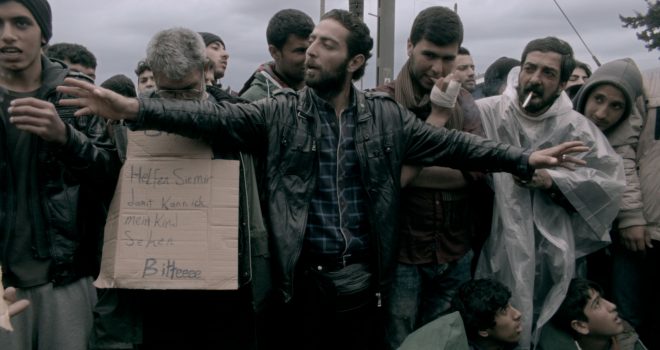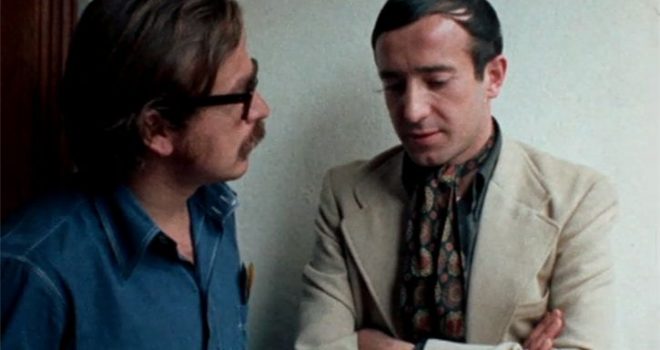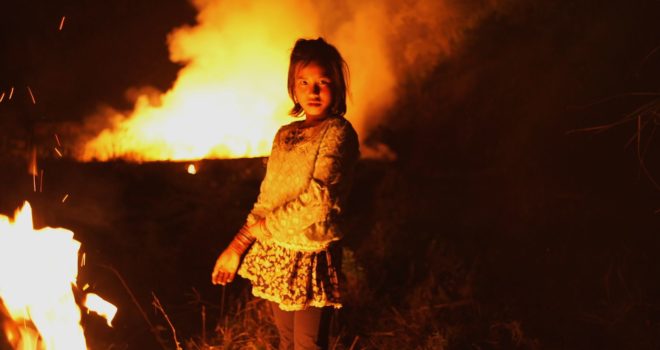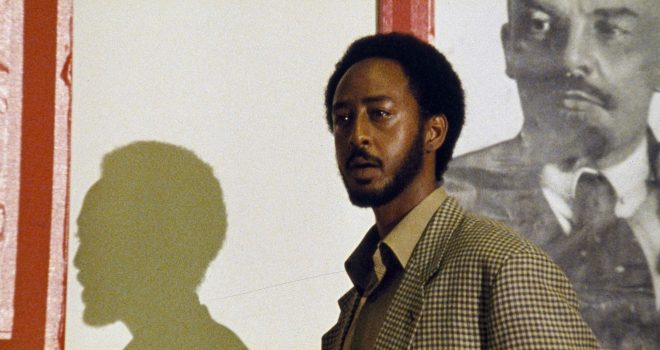His path was several paths, his blood, several horizons. And what if he turned in the past, found only two hands and dreamt the dream was fulfilled. Between me and my name, countries. In naming countries, I have lost my names. And passing though my name, I have not found the face of the countries. The dream came and he questioned it: Who, the eyes or the countries, came first?
Mahmoud Darwish, “That is her image, and this is the lover’s suicide” (1975)
The current exile of many populations in the direction of Europe has gone hand in hand with abundant discourses and inflated media images, often diffused as an emotional reaction and far- removed from any ethical consideration, which runs the risk of falling prey to abjection(1). In these communications, preference seems to have been given to the word “refugee”(2) rather than “exile”, thus prioritising the viewpoint of the presumed “hosts” – to the point of denying the pressing need to directly question the underlying causes of these displacements. And this, just at a time when we are, as the anthropologist Michel Agier reminds us, “de facto cosmopolitan, even without wanting or conceiving it”(3).
Rather than criticise the images whose effects smack of social control, we have searched through those that could make us think of exile. Is cinema able to offer an alternative to those images? Does it allow us to “transform the global foreigner, invisible and ghost-like, the person that identity- based policies leave nameless or voiceless, into a closer and relative otherness?(4) What can cinema do when its power is still seen as the revitalisation of an inevitable precariousness, or to reprise Serge Daney’s formulation, the cinema as a “home for images”(5), a place for the stories and forms repressed by the media’s norm?
To begin with, proposing a programme that explores exile implies taking a position vis-à-vis cinema, while also taking up a moral challenge: to avoid letting oneself be consumed by an issue that is way too hot(6). This is all the more delicate given that the “migration film”(7) or the “cinema of migration”(8)(9) seems to have become a “genre in its own right”. So as not to relinquish this intractable contemporaneity, yet avoid having our hands tied, what path should we take through existing films, and how should view those films just arriving?
By no means alien to the films that the 3 Continents(10) Festival has screened since its creation, this question was strongly present in the 38th edition in 2016. To being with, it appeared in the retrospective The theatre of remembering by Rithy Panh, partnered by the Institut d’Histoire du Temps Présent (IHTP)(11). From the first to the latest of his feature films – that is, from Site 2 (1989) to Exile (2016) – the Franco-Cambodian filmmaker has never ceased to pursue and be pursued by this question, as he himself had become an exiled filmmaker – a situation that, instead of cutting him from his roots, has enabled him to help foreigners to discover the history of his country, which he has constantly revisited so as to better highlight the rupture caused by the crimes of the Khmers Rouge.
Read more
But also, two films competing in 2016, Bangkok Nites by the Japanese Katsuya Tomita and In the Last Days of the City (Montgolfière d’Or and Young Jury Award) by the Egyptian Tamer El Saïd respectively addressed a chosen exile and the imminence of an imposed exile, taking a fictional approach and allowing autobiography to to rise to the surface. For his third film and for the first time, Katsuya Tomita filmed outside Japan in Thailand and Laos. He himself plays a Japanese character who had fled his country. “It’s sad to have no country to go to, consider Isan as the country of your birth” announces the ghost of a village in northern Thailand(12). In his first feature, Tamer El Saïd fondly follows the character Khalid, a young filmmaker who no longer knows how to film or live in Cairo and sees his friends from other Middle Eastern countries leave their home cities one by one. His film questions whether it is possible to find a correspondence between the elusive image of a collective body mired in a political and moral crisis and the intimate experience of each one.
On this occasion and drawing on a questionnaire prepared with Catherine Hass, an anthropologist attached to the IHTP, we interviewed the two filmmakers. We wanted to share this word “exile” with them, to set aside our cinephile speculations, or rather refresh them in a conversation about a work in progress. Katsuya Tomita told us that, when filming Bangkok Nites, he became aware that Thailand had become his home country and that this experience had also given him the freedom and the desire to return to Japan one day to film. Tamer El Saïd confided to us that he no longer feels at home anywhere and that the only place where the urgency of filming is felt is in fact in Cairo, despite the impossibility of continuing to live in the country’s political context. So, for them, cinema embodies the promise of being able to feel less “homesick for one’s country” and perhaps to get rid of all the “sickness of one’s country”. These shared words led us to abandon the paths of a pointless nostalgia. To decide on this programme, we constantly returned to the complexity of individual and collective migratory dynamics, to the hybridised identities operative in the long run, and to the random transnational comings and goings. Becoming a foreigner: this idea gradually imposed itself as the prism determining our choice of films. It was up to us to understand the word “exile” in the plural, in all its multiple dimensions(13) rather than its fixed determinations, and the inner itineraries without withdrawing into oneself. We avoided the mechanical repetition of terms always associated with exile but never (re) defined: border, identity, national, asylum, illegal, undocumented…
So, what path is covered from the first to the last film in this programme, from the indispensable America, America (1963) to Spectres Are Haunting Europe (2016), Maria Kourkouta and Niki Giannari’s first feature film?(14) Could it be that their points of departure and arrival, rather than being different, continually come to meet? With no concern for exhaustiveness, the eight films presented this year cover a little over half a century. This broad span enabled us to encompass in our present sighting more distant situations, some of which have already escaped our memory. We also hoped that the differences between the films would be heightened, while remaining open to the call of other images, those of times past and doubtless those of the future, as the status of exile is unfortunately not likely to disappear. In any case, we are certain that the point at which these eight film come to meet is to be found in the experience become film and not in the subject become images.
By making America, America, Elia Kazan shook up the energies of the Hollywood machine (can we separate its power from the cosmopolitanism that feeds it?). To recount his uncle’s exile from the Ottoman Empire to the United States, he blended very diverse registers: the autobiographical experience, the use of an almost documentary approach and the feeling of a loss of identity. Returning to this seminal itinerary of Kazan’s own decision to go to New York just before World War I, the filmmaker explores at the person he has become through a painful and traumatic process of acculturation.
With Dialogue of Exiles (1974), Raoul Ruiz transforms his recent arrival in France into filmic moments that probe the expectations and thoughts of a re-formed Chilean community. With no intention of realism, he stages the experience that he has just begun and which he observes among his already settled compañeros. Quando chegar o momento (Dôra) (1978) is also a shared filmic investigation between the Brazilian director Luiz Alberto Sanz, exiled in Sweden, and the Swedish director Lars Säfström, who espoused the Brazilian cause. It traces the suicide of a political activist unable to bear the future that awaits her as a foreigner far from her native land.
To resist the spiral of words, we also needed to find a spoken word, which implied recognising the reality of exile in an appropriate language, redeployed by necessity. The title of Simone Bitton’s film, Mahmoud Darwish: As the land is the Language, dedicated to the Palestinian poet, also reminded us of this function of language as an imaginary refuge and invaluable testimony of the dualities caused by exile.
Haile Gerima’s Teza (2008) and Ann Hui’s Song of Exile (1990) tell stories of characters who return to their point of departure. Very different in their purpose and form, flashbacks structure the stories of both films and produce paradoxical and terrible consequences. Rather than projecting the reparation that these stories can bring through an accumulation, they show the stages of the dislocation of an identity – heightened by an ideological impasse in the case of Gerima, and an irreconcilable genealogy in the case of Ann Hui.
In Ta’ang (2016), Wang Bing closely follows an ethnic minority group towards the other side of the border, in China. He takes the risk of returning to his country in images, certainly, but also completely illegally. In Spectres Are Haunting Europe (2016), Maria Kourkouta and Niki Giannari are in search of a fitting frame to film daily life in the Idomeni camp. They shun all sensationalism or passive recording of reality, and finally reveal that, as Greeks, they have also internalised a past of forced displacements – the burden of foreigners.
At the previous edition of the festival, we asked Tamer El Saïd and Katsuya Tomita if they thought it possible to film exile. Although it remained unanswered, this question did not evaporate for us. The eight films selected, re-seen or discovered in the darkness of a film theatre, nonetheless seem to help us tangibly feel the foremost setbacks of our cosmopolitan condition. They invite us to broaden the Festival’s 3 Continents to 5 and, along with Mahmoud Darwish, to carry the conviction that “all countries are far away” (15).
Claire Allouche, Jérôme Baron, Christian Delage, Claire Demoulin, Catherine Hass, Anne Kerlan, Mélisande Leventopoulos, José Quental
Notes
(1) Among contemporary writings on the question, we could cite Dork Zabunyan, “Une image de marque (sur la publication en une de la photo d’Aylan Shenu)”, Cahiers du Cinéma, no.715, October 2015
(2) “Migrants, refugees, illegals, immigrants, foreigners: these words to some extent overlap each other”, wrote the anthropologist Michel Agier, although he points out the word “refugee” is directly linked to the 1933 Nansen passport that allowed stateless refugees to move around, a statute that was later formalised in 1951 by the United Nations under the Geneva Convention and the creation of the UN High Commissioner for Refugees (UNHCR) that same year. Michel Agier, Les migrants et nous. Comprendre Babel, CNRS Editions, 2016, Paris, pp. 24–25.
(3) Michel Agier, La condition cosmopolite, Editions La Découverte, 2013, Lisieux, p 7.
(4) Michel Agier, Op. Cit., p. 207.
(5) Serge Daney, “Nick Ray et la maison des images”, Cahiers du Cinéma no. 310, April 1980.
(6) This image of fire marks the title of two recent films on this subject: Burn the Sea (2014) by Nathalie Nambot and Maki Berchache, and Fuocoammare, par-delà Lampedusa (2016) by Gianfranco Rosi, which literally means ‘the fire of the sea”.
(7) We should mention the growing importance of film screenings in the programming of the Musée national de l’immigration, notably with the festival “Visions d’exil”, held 10–18 November, this year.
(8) Annick Peigné-Giuly, “De l’Emigrant à Madame B.”, Images Documentaires : Exils, no. 87, December 2016, pp. 37–46.
(9) On this count, we could cite the recent publication of a book that addresses this question with some degree of historical and geographic completeness: Patricia-Laure Thivat (ed.), Voyages et exils au cinéma. Rencontre de l’altérité, Presses Universitaires du Septentrion, 2017.
(10) The list would be long, but we could mention notably Concerto for an Exile (1968) by the Ivorian director Désiré Ecaré, L’exilé (1980) by the Nigerian director Oumarou Ganda, Silvered Waters, Syrie Self-portrait (2014) by the Syrians Ossama Mohammed and Wiam Simav Bedirxan, Infinite Frontier (2007) by the Mexican director Juan Manuel Sepulveda and The Road to Mandalay (2016) by the Taiwanese director Midi Z.
(11) Moreover, the departmental correspondents of the Institut d’Histoire du Temps Présent are running the research programme “Accueillir les étrangers en France, 1965–1983”, which started late 2016.
(12) Already in 2011, with Saudade (awarded the 2011 Montgolfière d’or), Katsuya Tomita had questioned the entanglement of identities in the Brazilian immigration to Japan..
(13) The conception of exile obviously differs from one culture and language to another. This word posed problems for Léa Le Dimna (in the role of Katsuya Tomita), who explained to us that it varied depending on whether it was chosen or forced exile.
(14) We mention here: Georges Didi-Huberman, Niki Giannari, Passer, quoi qu’il en coûte, Editions de Minuit, 2017.
(15) Mahmoud Darwich, “Sirhane drinks his coffee in the cafeteria”.



